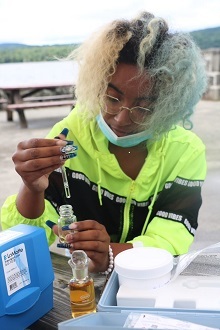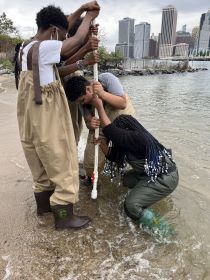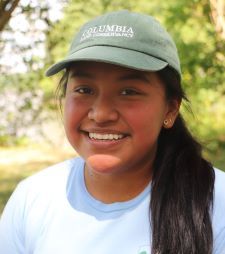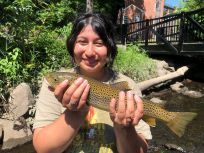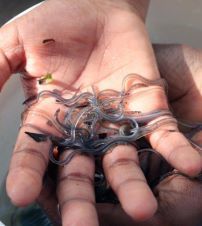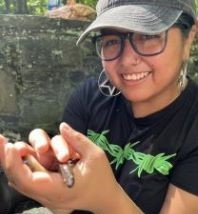Fostering the Next Generation of Environmental Scientists
The New York State Department of Environmental Conservation sent this bulletin on 12/20/2022 10:51 AM EST |
| DEC Delivers - Information to keep you connected and informed from the NYS Department of Environmental Conservation |
| Share or view as a web page || Update preferences or unsubscribe |
Hudson RiverNet
|
In This Issue:
Fostering the Next Generation of Environmental Scientists
To inspire and engage people to become good stewards of the tidal Hudson and its ecosystem, hands-on experience of the Hudson River is essential. DEC's Estuary Program in partnership with the Hudson River National Estuarine Research Reserve (HRNERR), provide a wide-range of education field programs, community science opportunities, interactive exhibits, and curricula to introduce students of all ages, young adults, and visitors to the fish, wildlife, and habitats of the Hudson River estuary and its watershed. A particular focus of this work is to provide paid research and field opportunities for students traditionally underrepresented in the sciences. In 2022, DEC's Estuary Program awarded $618,650 in funding for nine education projects, seven of which will launch or continue programs throughout the Hudson River Valley to help young adults develop skills in science, technology, engineering, and math (STEM) with a focus on the estuary ecosystem. In this issue we spotlight three young adults inspired by their participation in Estuary Program and HRNERR field-based research programs to begin college studies or start careers in the environmental sciences. A Day in the Life of the Hudson and Harbor
The waterfronts of the Hudson River and the piers of New York Harbor bustled with activity as thousands of students armed with seine nets, minnow pots, and water testing gear collected data and studied the Hudson River during DEC's 20th annual A Day in the Life of the Hudson and Harbor. From first grade to college-age, students participating in "Day in the Life" partner with DEC staff and environmental education centers to collect scientific data using hands-on field techniques, capturing a snapshot of the river's ecology. The program also gives students the opportunity to don waders or use a fishing rod to catch and identify some of the Hudson's 220-plus species of fish and myriad invertebrates. "A Day in the Life" is sponsored by DEC’s Hudson River Estuary Program in partnership with the HRNERR and Columbia Climate School's Lamont-Doherty Earth Observatory, with the help of 40 environmental organizations. Nearly 4,500 students and educators participated at 80 sites from New York Harbor to Waterford in 2022. Jenifer Rosete: From Student to Educator
Jenifer Rosete is in her second year as the conservation education coordinator for the Columbia Land Conservancy, working with schools, libraries, and community groups to get kids and adults outside. As a high school student, Jenifer participated in A Day in the Life of the Hudson and Harbor, donning waders to catch fish and collect data with her science class and teacher. Now, as an educator for the land conservancy, she works with the same teacher to take students to the Hudson River to participate in Day in the Life, now helping them catch fish and collect the data. “It’s a cool feeling to have been a student and now be on the other side as an educator, and rewarding to see the same excitement I experienced,” Jennifer said. She believes everyone should have access to the outdoors, and she inspires people of all ages to connect with nature and their local environment, especially the Hudson River. The Institute Discovering Environmental Scientists
The Institute Discovering Environmental Scientists (TIDES) is a paid, summer field-research and laboratory science experience with DEC’s Hudson River National Estuarine Research Reserve, the Hudson River Estuary Program, the Cary Institute of Ecosystem Studies, and the Margaret A. Davidson Graduate Fellowship. The program takes place at at the Norrie Point Environmental Center in Staatsburg. Students are provided transportation to help students from traditionally underserved areas participate in the program. High school and college students from communities across the Hudson Valley conduct environmental research projects along the banks of the Hudson River and in freshwater tidal wetlands examining the water quality, plant life, and fish biological diversity of the estuary. 2022 was the fourth year of the program, and many previous participants returned as mentors to guide new students through their projects. Guest scientists lead research seminars for the students throughout the program, introducing them to a wider world of environmental science monitoring and communication. The students worked together to formulate scientific questions, gather field data, conduct scientific analysis, and present their final research. Amy Oblitas-Rojas Gained Confidence Through TIDES
Amy Oblitas-Rojas joined TIDES the first year of the program in 2019 as a senior from Roy C Ketcham High School in Wappingers Falls. She was a shy participant who tentatively but willingly joined the student research team. Amy has returned to TIDES every summer since then, as she made her way through Dutchess Community College classes. She has just graduated from the School of Marine Sciences at Stony Brook University. She served as a college student mentor during the 2022 TIDES program, leading a research team and serving as a role model for the entire program. Her future goals include research or education in marine resources in the New York region. “TIDES has given me a lot of confidence as a person in STEM," Amy said. Eels Along the Hudson
From late March to early May, teachers, students, and partner environmental organizations participate in DEC’s Hudson River Eel Project to monitor migrating juvenile American eels (Anguilla rostrata). American eels hatch in the Sargasso Sea north of Puerto Rico, and every spring they arrive in estuaries like the Hudson River as translucent, two-inch long "glass eels." In 2022, the 15th year of the eel community science project, 937 volunteers helped catch, count, and release of 313,879 eels at 12 streams that flow into the tidal Hudson from Staten Island to Troy, contributing data for multi-state management plans for eel conservation. Brianna Estrada: High School Eel Project Volunteer to Estuary Educator
Brianna has been a part of the eel project for many years. She started as a Poughkeepsie High School student counting eels at the Fall Kill, and continued to participate in eel sampling at the Saw Kill while at Bard College. This summer, Brianna joined our education team as an Student Conservation Association/AmeriCorps member. On her very first day of work, she helped with electrofishing for eels and other fish with students from Poughkeepsie High School who participate in Dutchess County Cornell Cooperative Extension’s “No Child Left Inside Program,” in which she participated as a high school student. |

